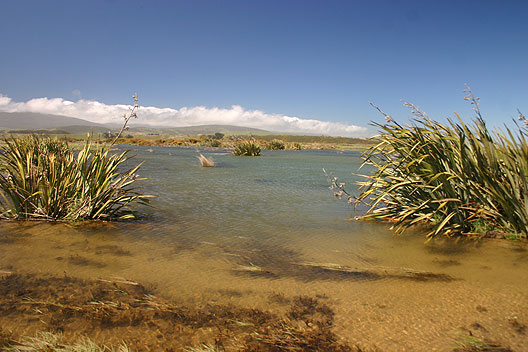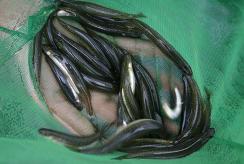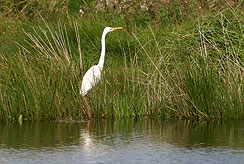 Location
Location
At the eastern side of the mouth of the Waiau River, this project is accessible from Fishing Camp Road off the Southern Scenic Route (30 minutes from Riverton, or coming from the other direction, 5 minutes from Tuatapere). Public access facilities have yet to be completed.
Project focus
The creation of rearing habitats for whitebait, whilst recognising the spinoff benefit for short and long-finned eel and a large diversity of wildlife which reside or migrate to this coastal environment.
 Newly developed wetland creating habitat for the whitebait fishery
Newly developed wetland creating habitat for the whitebait fishery
The whitebait fishery
New Zealand’s whitebait fishery is comprised of 5 species of native Galaxiids. This small migratory species spends part of their life cycle in freshwater and part in the marine environment.
 Inanga/whitebait - residents of the Te Waewae lagoon.
Inanga/whitebait - residents of the Te Waewae lagoon.
Galaxiid maculatus or inanga make up the largest percentage of the whitebait fishery. Adult fish spawn in vegetation at the margins of tidal wetlands and streams, during spring tides in the months of February to April. The fertilised eggs are washed to sea on the next spring tide and the hatch or “bait” return to freshwater from August to November of each year. They then inhabit small watercourses and wetlands in the coastal and lowland reaches of river systems, where they grow to maturity, reaching 80mm over 1-2 years and begin the cycle all over again. The incoming juvenile fish are the basis of the NZ whitebait fishery.
Why enhance rearing habitats
 A white heron sits eagerly anticipating its lunch
A white heron sits eagerly anticipating its lunch
Reduced flows in the Waiau River, development of low lying land for agriculture, drainage of wetlands in lowland and tidal areas and modification of lowland streams, have dramatically reduced rearing habitats. Spawning habitats have been affected by land use change and stock trampling and grazing.
What’s been happening
Between 1998 and 2008 the Trust has:
- created 90 small wetland habitats (over 6ha in area)
- established connecting channels between habitats and the tidal lagoon to ensure fish passage
- monitored the effectiveness of habitats as rearing habitats.
- Since 2008 the Trust has expanded the rearing habitat concept by:
- building 10ha (2009) of new open water wetlands, connected to the Waiau Lagoon that are slowly filling.
- building a further 10 ha (2012) of open water wetlands, which will fill and stabilise over time.
- surveying inanga and short-finned eel colonisation of wetlands and the bird species using the new habitats.
The Future:
- further wetland creation,
- ongoing monitoring of ecological response (fishery and wildlife response),
- establishment of public access roads and tracks and other on-site visitor facilities.
WATCH THIS SPACE!
This is a project in progress. We will update you as we make progress.

